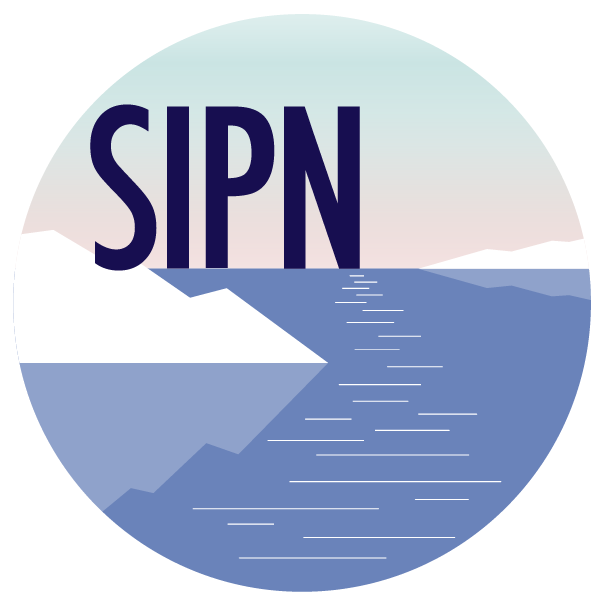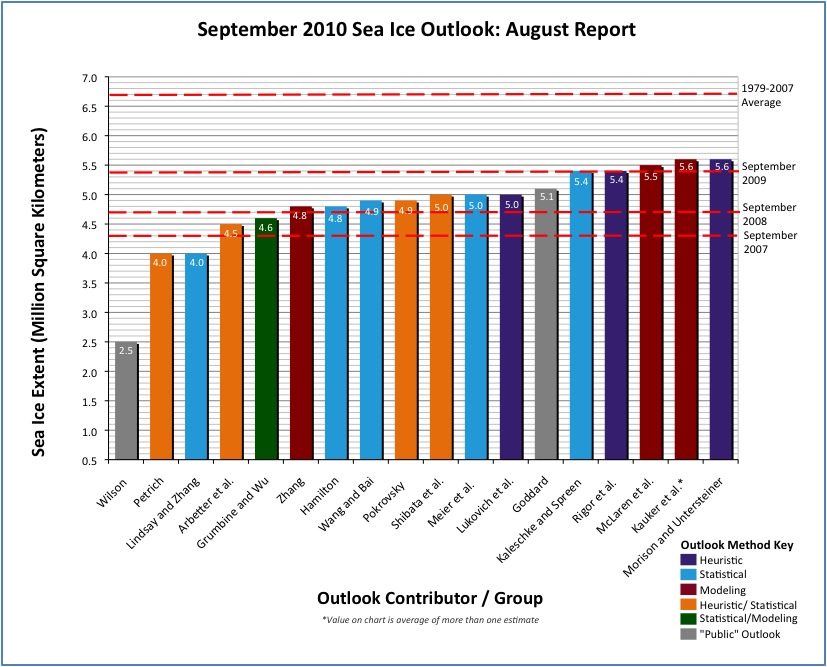Pan-Arctic Summary
For the August Outlook, a total of 18 contributions were received—16 from the scientific community and 2 from the general public. The mean prediction for the September minimum, excluding the two contributions from the general public, is 4.9 +/- 0.51 million square kilometers. This is a slight increase from the July Outlook of 4.8 +/- 0.62 million square kilometers and reflects in part the slowdown of ice loss observed in July. To put this estimate in context, this is below the 2009 minimum of 5.4 million square kilometers and represents a continuation of the long-term loss of summer arctic sea ice.
In July, the Arctic Dipole Anomaly (DA) pattern that was dominant in June (which promotes clear skies, warm air temperatures, and winds that push ice away from coastal areas and encourages melt) was replaced by low sea level pressure (SLP) over the Arctic Ocean, leading to ice divergence (ice extent "spreading out") and cooler temperatures. As a result, ice extent loss slowed. The July ice extent, however, still ended up as the second lowest recorded during the satellite (1979–2010) data record at 8.39 million square kilometers, 260,000 square kilometers above the average for July 2007.
August saw a return of high pressure over the Beaufort Sea coupled with low pressure over Siberia. This pattern helped to accelerate ice loss in the Beaufort and Chukchi Seas, where ice loss rates doubled in August. August also saw nearly ice-free conditions in the Northwest Passage (NWP) and the Northern Sea Route (NSR). Interestingly, two expedition teams, one from Norway and one from Russia, are attempting to circumnavigate the Arctic this season (http://www.ousland.no/blog/).
The estimates from the scientific community range from 4.0 to 5.6 million square kilometers, with 8 of the contributors suggesting a September minimum below 5.0 million square kilometers, 3 contributors suggesting a minimum of 5.0 million square kilometers, and 5 contributors suggesting a September minimum above 5.0 million square kilometers. Two contributors forecast a September minimum below that of 2007 at 4.0 million square kilometers and 3 contributors suggest a return to the long term downward linear trend for September sea ice loss (5.5 to 5.6 million square kilometers). None of the contributors indicate a return to the climatological sea ice extent of 6.7 million square kilometers.
Including all 18 contributions gives a September ice extent minimum of 4.8 +/- 0.77 million square kilometers, with a range of 2.5 to 5.6 million square kilometers.
Individual responses were based on a range of methods: statistical, numerical models, comparison with previous observations and rates of ice loss, or composites of several approaches.
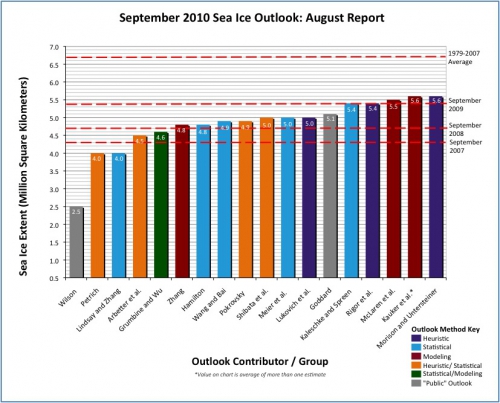
Pan-Arctic Full Outlook
This month, Julienne Stroeve, NSIDC, acted at guest editor for the Pan-Arctic Outlook.
OVERVIEW OF RESULTS
We received 18 outlook contributions for the August Pan-Arctic report—16 from the scientific community and 2 from the general public (Figure 1). The mean prediction for the September minimum based on all 18 contributions is 4.8 +/- 0.77 million square kilometers. Excluding the two contributions from the general public gives a minimum of 4.9 +/- 0.51 million square kilometers. All forecasts for the 2010 September minimum remain substantially lower than the climatological mean of 6.7 million square kilometers, and only 3 of the 18 contributors suggest a return to the long-term downward linear trend.
While many forecasts remained unchanged from the July Outlook, several contributors increased their estimates for the September minimum based on the slowdown of ice loss observed during July. Starting with ice conditions on 1 August, Meier et al. forecast a minimum of 5.0 million square kilometers if the ice continues to decline at a rate similar to climatology. Thus far, the ice loss rate for August (1-27 August) has been the same as climatology at around -54,000 square kilometers per day. With current ice conditions at 5.3 million square kilometers as of 27 August 2010 (source: National Snow and Ice Data Center, NSIDC) and two or three more weeks to go in the melt season, it is increasingly likely that the September ice extent will fall below the 2009 minimum. Currently the August (1-27 August) mean ice extent for 2010 is below the monthly mean for August 2008.

Wang and Bai discuss the importance of the persistence the Arctic Dipole Anomaly (DA) index used in their forecast. While the DA was replaced by low sea level pressure (SLP) over the Arctic Ocean in July, high pressure returned over the Beaufort Sea in August coupled with low pressure over Siberia, helping to compress ice towards the pole and bring warm air into the Arctic. AMSR-E sea ice concentrations (Figure 2) and MODIS visible imagery indicate the Beaufort and Chukchi Seas continue to show areas of less consolidated sea ice that may still disappear before the melt season is over.
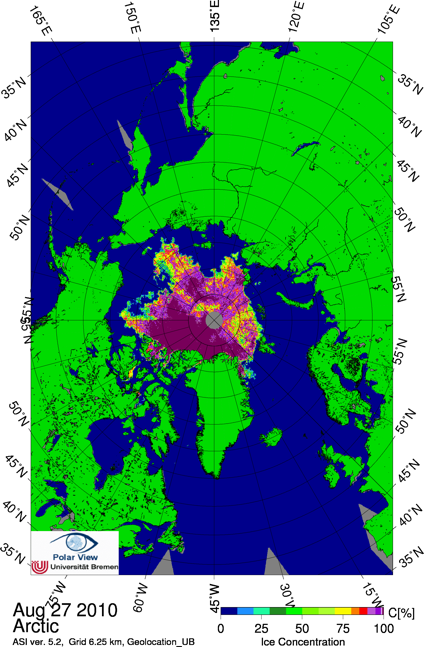
JULY AND AUGUST ICE AND ATMOSPHERIC CONDITIONS
As discussed in the July Outlook, low sea level pressure (SLP) dominated the Arctic Ocean in July, leading to ice divergence and cooler temperatures that helped to slow the fast pace of ice loss observed in May and June. The July 2010 average daily ice loss rate was -80,920 square kilometers per day, slower than the climatological rate of decline for July of -84,050 square kilometers per day, and significantly slower than that observed in 2007 (-107,270 square kilometer per day). The mean ice extent for July was 8.39 million square kilometers, the second lowest July ice extent observed during the satellite data record. The slowdown of ice loss in July contributed to upward revisions in 5 of the August Outlook contributions (e.g., Arbetter et al., Meier et al.; Kaleschke and Spreen; Kauker et al.; Lukovich et al.).
In August, higher pressure rebuilt in the Beaufort Sea together with low SLP over Siberia, helping to compact the ice towards the pole and leading to advection of warm, southerly air into the Arctic. Ice loss accelerated in the Beaufort and Chukchi seas at nearly twice the rate as observed during the month of July, whereas ice loss rates slowed in other regions (Figure 4). On average the daily ice loss rate for the Arctic as a whole during August was -54,000 square million square kilometers per day, or about average.
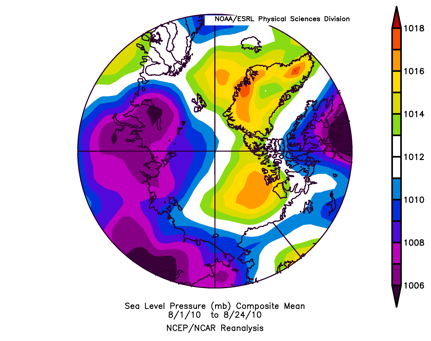
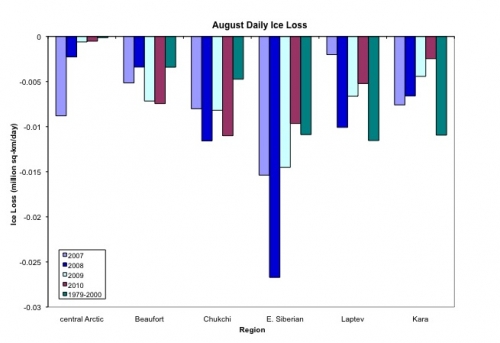
Survival of the tongue of old ice that was transported into the Beaufort and Chukchi Seas during the extreme negative phase of the Arctic Oscillation (AO) of winter 2009/2010 has been a key player to the evolution of the summer sea ice cover. In situ observations show this ice has been drifting westwards, taking drifting buoys with it into the East Siberian Sea. While International Arctic Buoy Programme (IABP) information had indicated much of this ice might survive the summer, the latest ice age map provided by J. Maslanik (Figure 5), shows that the tongue of old ice has mostly melted away, except for some isolated floes. Rapid progress made by a surface vessel (RV Xuelong from China) in the Pacific Arctic sector also indicates the advanced state of (predominately first-year) ice decay in this area (see contribution by Hutchings with a summary of ground-based observations of ice retreat).
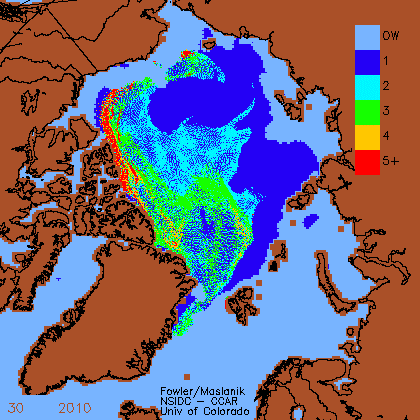
NORTHERN SEA ROUTES
By the end of August, both the Northwest Passage (NWP) and the Northern Sea Route (NSR) were nearly ice-free. In early August, Environment Canada reported that sea ice conditions were very light in the NWP, with some ice still present at the mouth of M'Clure Strait and in Larson Sound. Envisat ASAR images from 22 August provided by L. Kaleschke show the NSR is nearly open (Figure 6). Details of ice conditions in this region are discussed in the Regional Sea Ice Outlook.
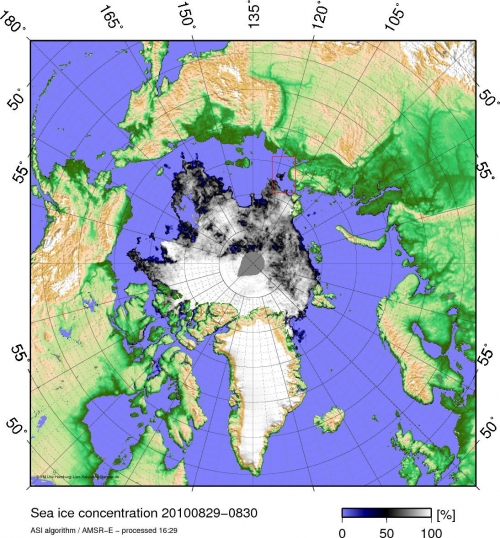
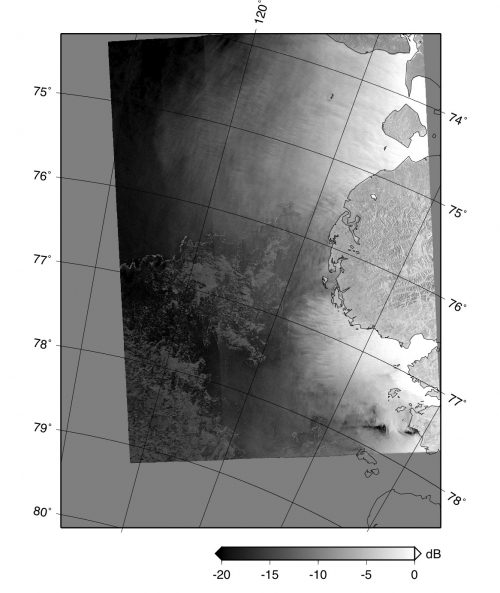
KEY STATEMENTS FROM INDIVIDUAL OUTLOOKS
Name (Organization of First Author); Estimate in Million Square Kilometers; Method Ordered from Greatest to Least Extent
Definitions of the different types of methods can be found in our Sea Ice Outlook glossary. PDFs of the individual contributions are at the bottom of this page.
Morison and Untersteiner (University of Washington); 5.6 Million Square Kilometers; Heuristic
Estimate is unchanged from last month and is based on the previous winter Arctic Oscillation (AO), ice concentrations observed during North Pole Environmental Observatory (NPEO) hydro surveys, atmospheric and ice surface conditions observed with NPEO buoys and Web Cams, and recent ice trajectories.
Kauker et al. (Alfred Wegener Institute for Polar and Marine Research); 5.6 Million Square Kilometers; Numerical Modeling
Note: this is an average of two predictions.
Ensemble I prediction: 5.65 +/- 0.22 million square kilometers (bias included)
Ensemble II prediction: 5.60 +/- 0.20 million square kilometers
Similar to the June and July Outlook, use was made of the 4DVar data assimilation system NAOSIMDAS to perform an additional set of ensemble experiments starting from an initial state determined via data assimilation. The Ensemble I prediction is a decrease from the previous July Outlook prediction of 5.78 million square kilometers, whereas the Ensemble II prediction is an increase from the previous 5.33 million square kilometers. Note that in contrast to the June and July Outlook contributions, the two Ensembles give nearly identical estimates for the September minimum.
McLaren et al. (Met Office Hadley Centre); 5.5 Million Square Kilometers; Modeling
Prediction is based on an experimental model prediction from the Met Office Hadley Centre seasonal forecasting system (GloSea4). The September 2010 prediction uses the ensemble mean from 42 runs (3 different start dates each used for 14 runs with different perturbed physics) starting in May. The standard deviation of the ensemble September prediction is 0.4 million square kilometers. The system is in continuous development and currently the sea ice model is initialized with ice that is too thick, hence this prediction is expected to be an upper estimate.
Rigor et al. (Polar Science Center, University of Washington); 5.4 Million Square Kilometers; Heuristic
The August outlook value remains unchanged from the July and June values. Like the previous months, the estimate is based on prior winter Arctic Oscillation (AO) conditions and the spatial distribution of ice of different age classes.
Kaleschke and Spreen (University of Hamburg); 5.4 Million Square Kilometers; Statistical
Estimate is based on AMSR-E sea ice concentrations that are regressed against previous years' September mean ice extent. Improvements were made to the statistical method, including the use of high resolution AMSR-E sea ice concentration data, a time-domain filter of five days that reduces observational noise, and a space-domain selection that neglects the outer seasonal ice zones. The August outlook of 5.4 + 0.1 million square kilometers is an increase from the July outlook of 5.2 million square kilometers.
Lukovich et al. (University of Manitoba); 5.0 Million Square Kilometers; Heuristic
An update to the previous heuristic assessment of surface, stratospheric, and ice conditions in 2010 relative to 2007 atmospheric and ice conditions for July provide the basis for projection of September sea ice extent. This is an increase of 1 million square kilometers from the July Outlook, reflecting the persistence of low sea level pressure (SLP) over the central Arctic that resulted in ice divergence and a more fractured ice cover. While the SLP high in 2007 contributed to the accelerated retreat of the ice cover, the persistent SLP low in July 2010 substantially slowed the decline in ice extent.
Meier et al. (National Snow and Ice Data Center); 5.0 Million Square Kilometers; Statistical
Here the method of Meier et al. in the July Outlook is updated using daily decline rates from 1 August until the minimum extent is reached as applied to the observed 1 August ice extent. Using average daily decline rates from 1979-2000 yields a minimum extent of 5.0 million square kilometers. Using rates from 2008, which showed rapid late summer ice loss, would yield a minimum of 4.09 million square kilometers, whereas using rates from 2006 when the decline from August to September was slower than normal would yield a minimum of 5.27 million square kilometers. Thus far, August ice loss has been close to the 1979-2000 average.
Shibata et al. (Kitami Institute of Technology and Japan Aerospace Exploration Agency); 5.0 Million Square Kilometers; Heuristic, Statistical
Prediction is based on estimated sea ice thickness derived from AMSR-E 36 GHz polarization ratio, typical estimates for ice loss due to melting and outflow through Fram Strait and cloudiness. Assuming no unique atmospheric influence on ice loss in 2010 gives a September minimum of 5.0 million square kilometers.
Pokrovsky (Main Geophysical Observatory, Russia); 4.9 Million Square Kilometers; Heuristic and Statistical
Estimate is unchanged from last month. September sea ice extent is predicted through analysis of three climate indicators: the Atlantic Multidecadal Oscillation (AMO), Pacific Decadal Oscillation (PDO), and Arctic Oscillation (AO) for the last 30 years. Circulation fields for May through June resulted in hot air masses from south Asia and Africa entering Siberia and the Russian Arctic, as well as increasing sea surface temperatures (SSTs) in the North-East Atlantic domain, subjecting the relatively thin ice cover to rapid melting.
Wang and Bai (National Oceanic and Atmospheric Administration); 4.9 Million Square Kilometers; Statistical
Prediction is based on regression of September ice area to the summer Dipole Anomaly (DA) index. Since the summer DA index for the average of June and July is 3.218, the projected September minimum is 4.93 million square kilometers. This projection may vary depending on the August DA index (sign and magnitude) since the summer DA index is defined as the mean from June through August in the prediction.
Hamilton (University of New Hampshire); 4.8 Million Square Kilometers; Statistical
Prediction for September ranges from 4.0 to 5.5 million square kilometers and is determined statistically from the July ice extent, July ice concentration, and the previous year's September ice extent.
Zhang (Polar Science Center, University of Washington); 4.8 Million Square Kilometers; Modeling
Estimate is unchanged from last month and is once again based on ensemble predictions, now starting on 1 August 2010. The ensemble predictions are based on a synthesis of a model, NCEP/NCAR reanalysis data, and satellite ice concentration data. The model indicates most of the Northwest Passage is ice free except for some thin ice in the Lancaster Sound. It is likely that no ice will be there in September.
Grumbine and Wu (National Oceanic and Atmospheric Administration); 4.6 Million Square Kilometers; Statistical and Numerical Modeling
Model-based prediction using April 2010 starting conditions. The raw output of the model is adjusted for known model bias towards high extent and thickness. After adjustment, the ensemble mean estimate is 4.60 million square kilometers for September, down from the 5.13 million square kilometers of the first estimate. The 16 member ensemble's range is 4.37 to 4.94 million square kilometers.
Arbetter et al. (National Ice Center); 4.5 Million Square Kilometers; Statistical/Heuristic
Compared to the earlier outlooks, the current estimate is more conservative. The September minimum will remain far below the 1979-2000 average, but will not be record setting, according to the revised estimates. In addition, previous Outlooks predicted an open Northern Sea Route, but the latest Outlook shows some ice remains in the area and may persist through the end of summer. Although it is not possible to directly predict ice in the Northwest Passage (NWP), M'Clure Strait is iced in according to our Outlook, while Amundsen Gulf and the Alaskan North Shore are all accessible. The estimate remains a low bias for prediction versus actual because the area in the Canadian Arctic Archipelago (CAA) is not accounted for.
Lindsay and Zhang (Applied Physics Laboratory, University of Washington); 4.0 +/- 0.34 Million Square Kilometers; Statistical PIOMAS
This value is unchanged from last month and is based on the PIOMAS model results, which indicate the ice has continued to thin at a fast rate. The best predictors for the September minimum are G1.0 (area with less than 1.0m of ice) and G0.4 (area with less than 0.4 m of ice), both of which give nearly identical results. Using the G1.0 predictor that was used in the previous outlook contributions gives a prediction of 3.96 +/- 0.34 million square kilometers, with an R2 value of 0.84, indicating a high degree of skill in the forecast.
Petrich (University of Alaska Fairbanks); 4.0 Million Square Kilometers with a Possible Range of 3.4 to 5.4 Million Square Kilometers, Likely Range of 3.4 to 4.9 Million Square Kilometers; Heuristic, Statistical
Estimate is unchanged from last month and is based on the relationship between June sea level pressure (SLP) and both surface winds and clouds, which are known to drive arctic sea ice reduction in summer. The mean June SLP is used as a proxy for September sea ice extent because the association appears to be stronger than for any other month.
Public Contributions:
Goddard (contributor at wattsupwiththat.com blog); 5.1 Million Square Kilometers; Heuristic, Statistical
Method is based on numerical and visual comparison of the PIPS2 model thickness distributions in the Arctic Basin for the last ten years vs. the current year. May 2010 had less ice than May 2006, but similar distribution ratios of ice thickness - so the prediction was that the 2010 minimum would be lower than 2006 and higher than 2009. This hindcast method was effective for all years except 2007 - when wind appears to have piled the ice up at higher latitudes at the expense of extent loss. Similar winds developed in mid-August, requiring the forecast to drop by 8%. It is now expected that the season will end with ice extent slightly below 2009.
Wilson (no organization provided); 2.5 Million Square Kilometers; Statistical and Heuristic
Statistical relationship between ice loss and relative strength of El Nino is used for the September minimum.
| Attachment | Size |
|---|---|
| Combined Individual Outlook Contributions18.19 MB | 18.19 MB |
| Attachment | Size |
|---|---|
| Morison and Untersteiner (July Outlook)30.64 KB | 30.64 KB |
| Kauker et al.345.71 KB | 345.71 KB |
| McLaren et al. (July Outlook)197.68 KB | 197.68 KB |
| Rigor et al.5.41 MB | 5.41 MB |
| Kaleshke and Spreen (July Outlook)1.8 MB | 1.8 MB |
| Lukovich et al. (July Outlook)2.96 MB | 2.96 MB |
| Meier et al.240.61 KB | 240.61 KB |
| Shibata et al.1.32 MB | 1.32 MB |
| Pokrovsky (July Outlook)255.86 KB | 255.86 KB |
| Wang and Bai81.45 KB | 81.45 KB |
| Hamilton839.77 KB | 839.77 KB |
| Zhang147.8 KB | 147.8 KB |
| Grumbine and Wu33.93 KB | 33.93 KB |
| Arbetter et al.122.42 KB | 122.42 KB |
| Lindsay and Zhang (July Outlook)714.04 KB | 714.04 KB |
| Petrich (July Outlook)40.09 KB | 40.09 KB |
| Public Contribution - Goddard45.56 KB | 45.56 KB |
| Public Outlook - Wilson2.66 MB | 2.66 MB |
| Ship Observations - Hutchings734.29 KB | 734.29 KB |
| Attachment | Size |
|---|---|
| Arbetter et al.125.18 KB | 125.18 KB |
| Gerland et al.737.54 KB | 737.54 KB |
| Gudmandsen61.28 KB | 61.28 KB |
| Howell and Agnew3.05 MB | 3.05 MB |
| Lukovich et al. (July Outlook)2.98 MB | 2.98 MB |
| Tivy (July Outlook)180.15 KB | 180.15 KB |
| Zhang147.8 KB | 147.8 KB |
| Ship Observations - Hutchings732.51 KB | 732.51 KB |
